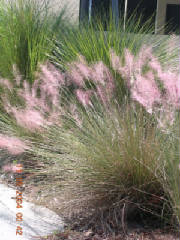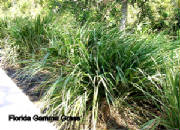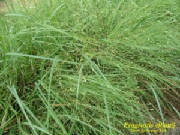Most ornamental grasses can be quite dramatic as they add a light airy look to the landscape, especially
when planted in groups. These grasses have a different look - a bit more informal or maybe a little wild. Ornamental
grasses are dynamic with the size, color, shape and texture changing as each season progresses. It is always a good
idea to do some research before you decide to plant any ornamental grass, especially with regard to the mature size and spreading
potential of each variety.
Ornamental grasses have become popular for use in landscapes.
Many are fairly drought tolerant, or tolerant of a wide range of conditions. Sand cord grass (Spartina alternaflora),
for instance, will thrive in wet spots near both fresh and salt water. But if a drought comes, it does just fine without
significant added water.
The grasses that are most commonly seen in the nurseries
are Gulf Muhly grass (Muhlenbergia capillaris), Purple fountain grass (Pennisetum setaceum 'Rubrum') and Green fountain
grass (Pennisetum setaceum). The University of Florida has determined that Green fountain grass has invasive
potential and should not be used in our area.
(Muhlenbergia capillaris), Purple fountain grass (Pennisetum setaceum 'Rubrum') and Green fountain
grass (Pennisetum setaceum). The University of Florida has determined that Green fountain grass has invasive
potential and should not be used in our area.
Gulf Muhly grass grows in a clump about
three feet tall. In the fall purplish pink feathery flowers cover each plant are a held high above the leaves.
This grass is salt tolerant and very drought tolerant once established. Muhly grass can be pruned down to about twelve
inches in February or just the ragged seed heads can be removed.
Red fountain grass grows
about four feet tall and two to three feet wide with lovely maroon leaves and tall arching seed heads. This grass can
be sensitive to freezing temperatures. The whole plant should be pruned down to about eight inches high in February.
This will remove any dead growth and old seed heads while encouraging rapid new growth.
 Others that I like are native grasses that may be a bit harder to find. Florida Gamma grass (Tripsacum floridanum)
is sometimes called dwarf Fakahatchee grass. It is evergreen and grows two to three feet high by about four feet wide
and has interesting seed heads. This grass is evergreen, likes full sun to part shade and is virtually free of pests.
Others that I like are native grasses that may be a bit harder to find. Florida Gamma grass (Tripsacum floridanum)
is sometimes called dwarf Fakahatchee grass. It is evergreen and grows two to three feet high by about four feet wide
and has interesting seed heads. This grass is evergreen, likes full sun to part shade and is virtually free of pests.
Elliott's Lovegrass (Eragrostis elliottii) is a low, graceful, fine-textured grass with beautiful, silvery-blue leaves and masses of tiny, delicate flower spikes. It forms clumps
of narrow powder-blue foliage that rises to about 18-24" tall. The 3 foot tall flowers stalks rise in mid to late
spring, opening into a buff colored haze of flowers that lasts into fall and winter. Plant this drought tolerant grass in
full sun to light shade in well drained soil. Purple Lovegrass (Eragrostis spectabilis) has a similar profile
to the Elliott's Lovegrass listed above. The differences are that the blooms are lavender and the leaves are green.
graceful, fine-textured grass with beautiful, silvery-blue leaves and masses of tiny, delicate flower spikes. It forms clumps
of narrow powder-blue foliage that rises to about 18-24" tall. The 3 foot tall flowers stalks rise in mid to late
spring, opening into a buff colored haze of flowers that lasts into fall and winter. Plant this drought tolerant grass in
full sun to light shade in well drained soil. Purple Lovegrass (Eragrostis spectabilis) has a similar profile
to the Elliott's Lovegrass listed above. The differences are that the blooms are lavender and the leaves are green.
Sand cord grass that I mentioned earlier is a large grass, so it is not for small spaces. It grows four to
six feet high and wide, but it does make a statement in the right places. It is shown at the back of the picture of
Gulf Muhly grass above.
Coastal bluestem (Schizachyrium maritimum) is a smaller
creeping grass with blue-gray foliage that dies to the ground each winter, but will come up again each spring. This
grass grows one to two feet tall, and the creeping habit means this grass will spread.
Another
grass that is not native and is normally grown as an herb is Lemongrass (Cymbogon citrates). It is fragrant
and elegant, growing to six feet tall. It requires moist soil with lots of organic matter and it is frost tender.
But it has the added bonus that you can use it as a flavoring in cooking.
Please reference
the University of Florida/IFAS Extension publication, Selection and Use of Ornamental Grasses on the Internet at
http://edis.ifas.ufl.edu/pdffiles/EP/EP23300.pdf for extensive information on the various grasses that can be used in Florida along with their mature size
and appropriate region of Florida for growing them.

